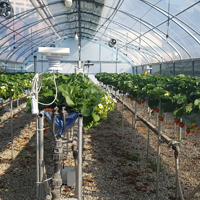Effect of glazing configuration as an energy-saving strategy in naturally ventilated greenhouses for strawberry (Seolhyang sp.) cultivation

Published:10 May 2021
Abstract Views: 1127
PDF: 625
HTML: 34
HTML: 34
Publisher's note
All claims expressed in this article are solely those of the authors and do not necessarily represent those of their affiliated organizations, or those of the publisher, the editors and the reviewers. Any product that may be evaluated in this article or claim that may be made by its manufacturer is not guaranteed or endorsed by the publisher.
All claims expressed in this article are solely those of the authors and do not necessarily represent those of their affiliated organizations, or those of the publisher, the editors and the reviewers. Any product that may be evaluated in this article or claim that may be made by its manufacturer is not guaranteed or endorsed by the publisher.
Similar Articles
- Vidas Damanauskas, Algirdas Janulevičius, Effect of tillage implement (spring tine cultivator, disc harrow), soil texture, forward speed, and tillage depth on fuel consumption and tillage quality , Journal of Agricultural Engineering: Vol. 53 No. 3 (2022)
- Qazeem Opeyemi Ogunlowo, Adedayo Afeez Azeez, Wook Ho Na, Anis Rabiu, Misbaudeen Aderemi Adesanya, Ezatullah Zakir, John Ademola Ijadunola, Bukola Olanrewaju Afolabi, Babajide Saheed Kosemani, Titus Adeyinka Ilori, Hyun-Woo Lee, Analysis of microclimate temperature and relative humidity distribution of local poultry house in a subtropical area of Nigeria , Journal of Agricultural Engineering: Vol. 55 No. 2 (2024)
- Daniele Torreggiani, Alberto Barbaresi, Francesca Dallacasa, Patrizia Tassinari, Effects of different architectural solutions on the thermal behaviour in an unconditioned rural building. The case of an Italian winery , Journal of Agricultural Engineering: Vol. 49 No. 1 (2018)
- Alberto Cadei, Omar Mologni, Luca Marchi, Francesco Sforza, Dominik Röser, Raffaele Cavalli, Stefano Grigolato, Energy efficiency of a hybrid cable yarding system: A case study in the North-Eastern Italian Alps under real working conditions , Journal of Agricultural Engineering: Vol. 52 No. 3 (2021)
- Alessandro D'Emilio, Simona M.C. Porto, Giovanni Cascone, Marco Bella, Marco Gulino, Mitigating heat stress of dairy cows bred in a free-stall barn by sprinkler systems coupled with forced ventilation , Journal of Agricultural Engineering: Vol. 48 No. 4 (2017)
- Hui Yang, Yuhao Li, Chengguo Fu, Rongxian Zhang, Haibo Li, Yipeng Feng, Yaqi Zhang, Hongbin Cong, Fuquan Nie, Research on inspection route of hanging environmental robot based on computational fluid dynamics , Journal of Agricultural Engineering: Vol. 55 No. 2 (2024)
- Timothy Denen Akpenpuun, Qazeem Opeyemi Ogunlowo, Wook-Ho Na, Prabhat Dutta, Anis Rabiu, Misbaudeen Aderemi Adesanya, Mohammadreza Nariman, Ezatullah Zakir, Hyeon Tae Kim, Hyun-Woo Lee, Dynamic neural network modeling of thermal environments of two adjacent single-span greenhouses with different thermal curtain positions , Journal of Agricultural Engineering: Vol. 55 No. 2 (2024)
- Francesco Barreca, Pasquale Praticò, Giuseppe Davide Cardinali, A low-energy storage container for food and agriculture products , Journal of Agricultural Engineering: Vol. 52 No. 3 (2021)
- Shahad Al-Rikabi, Enrica Santolini, Beatrice Pulvirenti, Marco Bovo, Alberto Barbaresi, Daniele Torreggiani, Patrizia Tassinari, Definition of thermal comfort of crops within naturally ventilated greenhouses , Journal of Agricultural Engineering: Vol. 54 No. 4 (2023)
- Giuliano Vox, Pierfrancesco Losito, Fabio Valente, Rinaldo Consoletti, Giacomo Scarascia-Mugnozza, Evelia Schettini, Cristoforo Marzocca, Francesco Corsi, A wireless telecommunications network for real-time monitoring of greenhouse microclimate , Journal of Agricultural Engineering: Vol. 45 No. 2 (2014)
You may also start an advanced similarity search for this article.

 https://doi.org/10.4081/jae.2021.1177
https://doi.org/10.4081/jae.2021.1177 











